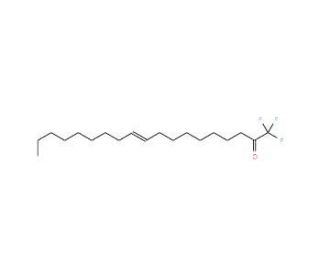

Oleyl trifluoromethyl ketone の分子構造、CAS番号: 177987-23-4
Oleyl trifluoromethyl ketone (CAS 177987-23-4)
CAS 番号:
177987-23-4
分子量:
334.46
分子式:
C19H33F3O
補足情報:
これは輸送上の危険物に分類され、追加の送料が発生する場合があります。
試験・研究用以外には使用しないでください。 臨床及び体外診断には使用できません。
* Refer to Certificate of Analysis for lot specific data.
クイックリンク
注文情報
説明
技術サポート情報
安全情報
SDSと分析証明書
オレイルトリフルオロメチルケトン(CAS番号177987-23-4)は、長鎖不飽和オレイル基とトリフルオロメチルケトン官能基をブレンドした特殊な化合物である。このユニークな組み合わせにより、この分子には疎水性と高電子陰性元素の両方が付与され、化学および材料科学研究の興味深いテーマとなっている。トリフルオロメチル基の存在は、分子に大きな電子吸引性を与え、反応性や求核種との相互作用に影響を与える。この特性は、フッ素化有機化合物の安定性、反応性、応用の可能性を研究する有機フッ素化学の研究において特に価値がある。オレイルトリフルオロメチルケトンの構造は、さまざまな有機反応において界面活性剤や相間移動触媒としての役割を果たし、有機化合物の水溶液への溶解性を高めたり、逆に水溶液への溶解性を低下させたりするのに役立つ。さらに、この化合物の安定した層や界面を形成する能力は、フッ素化コーティングやフッ素化フィルムの作成に活用され、耐薬品性の向上や低表面エネルギー特性で注目されている。これらの特性は、撥油性、撥水性、摩擦低減を必要とするコーティング用の先端材料を開発する上で極めて重要である。研究面では、オレイルトリフルオロメチルケトンは脂質二重膜や膜ダイナミクスの研究、特にフッ素化化合物が生体膜や合成膜とどのように相互作用し、その構造や機能に影響を与えるかの研究にも使用されている。
Oleyl trifluoromethyl ketone (CAS 177987-23-4) 参考文献
- 脂肪酸アミドヒドロラーゼのトリフルオロメチルケトン阻害剤:阻害に寄与する構造とコンフォメーションの特徴のプローブ。 | Boger, DL., et al. 1999. Bioorg Med Chem Lett. 9: 265-70. PMID: 10021942
- ラットとニワトリの脳内脂肪酸アミドヒドロラーゼの薬理学的特性の違い。 | Fowler, CJ., et al. 2000. Br J Pharmacol. 131: 498-504. PMID: 11015300
- 脂肪酸アミドヒドロラーゼ活性測定のためのハイスループット対応アッセイ。 | Wilson, SJ., et al. 2003. Anal Biochem. 318: 270-5. PMID: 12814631
- 脳微小血管内皮細胞におけるアナンダミドの代謝。 | Chen, P., et al. 2004. Prostaglandins Other Lipid Mediat. 73: 59-72. PMID: 15165032
- 脳微小血管内皮におけるアナンダミドによるシクロオキシゲナーゼ-2の誘導。 | Chen, P., et al. 2005. Microvasc Res. 69: 28-35. PMID: 15797258
- 脂肪酸アミドヒドロラーゼ活性測定のためのハイスループット蛍光アッセイ。 | Kage, KL., et al. 2007. J Neurosci Methods. 161: 47-54. PMID: 17083980
- 脂肪酸アミドヒドロラーゼ(FAAH)阻害剤の発見と開発。 | Otrubova, K., et al. 2011. Bioorg Med Chem Lett. 21: 4674-85. PMID: 21764305
- 脂肪酸アミドヒドロラーゼ(FAAH)の強力な阻害剤としての2-アミノ-5-アリールベンゾオキサゾール誘導体。 | Estiarte and M. Angels, et al. 2012. MedChemComm. 3.5: 611-619.
- 新しい生体外マウス調製法を用いた後背側被蓋核におけるFAAH阻害剤の効果の検討。 | Prabhala and Bala Krishna, et al. 2023. European Journal of Medicinal Chemistry Reports. 9: 100111.
注文情報
| 製品名 | カタログ # | 単位 | 価格 | 数量 | お気に入り | |
Oleyl trifluoromethyl ketone, 10 mg | sc-215630 | 10 mg | $141.00 |
